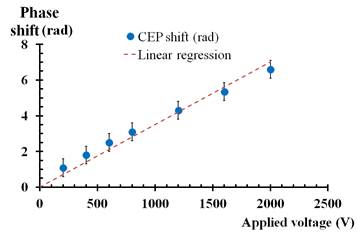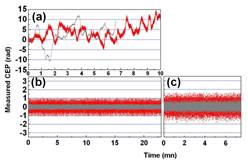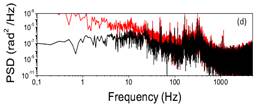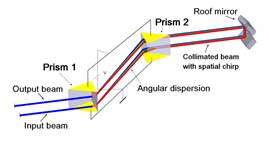Research and Development
R&D activities are essential to maintain the SLIC platforms at a high level of performances and to adapt them to the needs of national and international users. The main topics of R&D studied by the SLIC group over the period 2009-2013 are briefly presented in the next paragraphs. They mostly concern :
- Carrier Enveloppe Phase control of intense (energy per pulse >mJ) lasers
- Non Linear Optics with focus on large bandwidth second harmonic generation (SHG) and non-collinear optical parametric amplification (NOPA)
- Innovative diagnostics
- Characterisation of seeded UVX Free Electron Lasers
Carrier Enveloppe Phase control (CEP)
SLIC: M. Comte, L. Daniault, N. Federov, D. Garzella, Q. Germon, O. Gobert, J.-F. Hergott, F. Lepetit, P. D’Oliveira, M. Perdrix, O. Tcherbakoff.
Collaborations: Amplitude Technologies (X. Chen, P. Demengeot, P.-M. Paul), POLIMI/CUSBO (G. Sansone, F. Calegari), Observatoire de Paris (D. Rovera), FOM (G. Gademann), CELIA (D. Descamps).
Control of the CEP (Carrier Envelope Phase) is of prime importance in ultrafast science, especially for the production of isolated attosecond pulses. Many efforts were achieved by SLIC in this field.
In most laboratories, the correction of CEP drifts is done by mechanical displacements (change of optical path in a dispersive element) or using an acousto-optics dispersive filter. We recently proposed an innovative device to control CEP fluctuations [O. Gobert et al., Opt. Express 19, 5410-5418 (2011)]. This device is simple, low-cost and compact, with a response time that makes possible operation at high pulse repetition rates. It is based on the use of the linear electro-optic (EO) effect in a bulk material (LiNbO3 or RTP by example): under the action of an electric field applied to the crystal, the phase and group velocities of the laser pulses propagating through the crystal are independently changed, allowing full electronic CEP adjustment.
|
Measured CEP shift as a function of applied voltage |
The demonstration of the efficiency of this electro-optic shifter was carried out [J.-F. Hergott et al., Opt. Express 19, 19935-19941 (2011)] within IMPULSE which is a joint laboratory of CEA and Amplitude Technologies. The measurements were in very good agreement with the predictions of the calculation and led to a variation of the CEP of about 1 radian for an applied voltage of 300V to the selected crystal (4 cm long and 4 mm thick LiNbO3). This method has led to a CEA - Amplitude Technologies patent [O. Gobert et al., Patent FR2969841 (2010)].
An ultrashort CEP stabilized laser prototype using this stabilisation method was then developed within IMPULSE. It led to 300mrad and 450mrad shot to shot CEP stabilization at respectively 3W and 20W amplification (1 kHz).
Following these results and using the idea of [S. Koke et al., Opt. Lett. 33, 2545-2547 (2008)], we developed an original stabilisation loop with Amplitude Technologies. This loop is totally analogical and has therefore the advantage of being potentially faster than the first one we used which was partly digital and limited to a 20Hz correction bandwith. This resulted in a much larger frequency correction range (≈ 200Hz) leading to 300mrad shot to shot residual CEP noise for a 20W Ti:S laser operating at 10kHz. This constitutes one of the best stabilisations reported at these energies and has been performed on a Amplitude Technologies laser system located in CUSBO (Milano) in collaboration with G. Sansone [C. Feng et al. Opt. Express 21, 25248-25256(2013)].
|
|
Shot to shot (red dots) and 10 ms averaged (grey dots) measurement of stabilized CEP drift over 10 min of amplified pulses at 1kHz 3 W output (a) without slow feedback control. (b) with EO feedback loop over 25 min leading to RMS CEP noise of respectively 320 and 130 mrad and (c) over 7 min of amplified pulses at 1kHz 20 W output leading to RMS CEP noise of respectively 440 and 250 mrad. (d) Power Spectral Density of 10kHz 20W amplifier with (black) and without (red) fast analogical CEP stabilization device. |
|
One limitation of the above CEP shifter is that shifting the CEP changes the group delay by a few fs. We have introduced an original variant based on an EO dispersive prism pair in a compressor-like configuration and showed analytically that this set-up makes it possible to shift the CEP without changing the group delay [O. Gobert et al., Appl. Sci. 3, 168-188 (2013)]. Another great advantage is that, compared to the single crystal shifter described above, it is possible to significantly reduce the applied voltage for the same variation of the CEP. The prisms are EO crystals (RTP or LiNbO3 for example) on which an electric field is applied. The experimental demonstration of the device is ongoing.
|
EO prism pair CEP shifter. |
Non Linear Optics
Second Harmonic Generation at 400 nm.
SLIC: M. Al Sayed, M. Comte, N. Federov, O. Gobert, D. Guillaumet, G. Mennerat, R. Maksimenka, A. Mokrani, M. Perdrix.
Collaborations: FASTLITE (T. Oksenhendler), CRISTAL LASER (D. Lupinski), INC (J. Habib, C. Ramond, C. Prigent, D. Verrnhet), CEA CESTA (A. Bourgeade)
We pursued the development of our original set-up for broadband noncollinear second harmonic generation of 50 fs, 800nm fundamental pulses. Our approach is based on tilted pulse-fronts and chirped fundamental pulses [O. Gobert et al., Appl. Opt. 53, 2646-2655 (2014)] and was devised using the analysis of the three wave-mixing ultra-broadband phase-matching condition with tilted pulse-fronts detailed by A.V. Smith [A. V. Smith, Opt. Lett. 26, 719-721 (2001)].
Barium Borate (BBO) and Lithium Triborate (LBO) were chosen as nonlinear crystals. Tests at lower energy were done with BBO since this crystal provides better conversion efficiency than LBO and can accommodate larger spectral bandwidths; for high energy tests, LBO was used since it is available in large sizes In LBO, conversion efficiency up to 65% was obtained at low fundamental energy (mJ range). At higher fundamental energies (~ 50mJ), UV pulses with energy up to 20 mJ were demonstrated in a 6mm thick LBO crystal. The beam is of homogeneous, cylindrical super-Gaussian spatial profile with a diameter of 40mm at 1/e<sup>2</sup>. Temporal compression was achieved resulting in 45fs pulse duration measured with a UV Wizzler (Fastlite).
|
Temporal 400 nm (a) and spectral 800 nm (b) measurements using a wizzler (Fastlite) |
Non collinear optical parametric amplification.
SLIC: M. Al Sayed, M. Comte, N. Federov, O. Gobert, D. Guillaumet, G. Mennerat, R. Maksimenka, A. Mokrani, M. Perdrix.
Collaborations: FASTLITE (T. Oksenhendler), CRISTAL LASER (D. Lupinski).
We developed a visible white-light (WL) seeded non collinear optical parametric amplifier. Most of the Ti:S pump laser beam (800nm, 50fs) is doubled in a 0.5mm type I BBO crystal to generate 400nm narrow band pump pulses [X. Ribeyre et al., Optics Letters 26, 1173-1175 (2001)] with 300µJ energy. A small fraction of the 800nm beam generates a single-filament WL continuum that is seeded in the NOPA (1mm BBO crystal), its angle with the 400nm laser beam corresponding to the optimized full NOPA phase-matching bandwidth.
After a two-prism compressor, the typical output pulse energy is in the 10-20µJ range between 500 and 700nm (5% conversion efficiency). Pulse duration around 30fs was measured with a Wizzler (Fastlite).
SLIC: M. Comte, O. Gobert, S. Grabielle, F. Lepetit, G. Mennerat, M. Perdrix.
Collaborations: FASTLITE (S. Coudreau, V. Crozatier, N. Forget, R. Herzog, D. Kaplan, T. Oksenhendler), LIDYL-PHI (V. Gallet, F. Quéré)
Since the invention of the FROG technique [D. J. Kane et al., IEEE J. Quantum Electron. 29, 571-579 (1993)] and of the SPIDER technique [C. Iaconis et al., Opt. Lett. 23, 792-794 (1998)], new promising diagnostics have been proposed. Among them, the Self-Referenced Interferometry [T. Oksenhendler et al., Appl Phys B 99, 7–12 (2010)] achromatic technique, where the reference pulse is generated by XPW allows for a high temporal contrast. Within a collaboration project between Fastlite and our group, experimental tests and comparison with the SPIDER technique were done [A. Moulet et al., Optics Letters 35, 3856-3858 (2010)]. We also contributed to the implementation of the SEA SPIDER technique [T. Witting et al., Optics Letters 34, 881-883 (2009)] by the PHI team.
SLIC: D. Garzella, D. Guillaumet, O. Gobert, F. Lepetit, B. Mahieu, M. Perdrix
Collaborations: University of Nova Gorica (G. de Ninno), SPAM-ATTO (Th. Auguste, D. Gauthier), LOA (Ph. Zeitoun, G. Lambert)
The SLIC and ATTO groups at LIDYL have a long lasting experience in Free Electrons Lasers for more than 20 years. In 2008, SLIC and ATTO collaborated with the Synchrotron SOLEIL and the Japanese agency RIKEN in the world's first “HHG seeded FEL” experiment, where the 160 nm HHG emission was amplified by means of the interaction with the SCSS electron beam.
In the period 2009-2013, we collaborated with the ENEA-FRASCATI team in the SPARC experiment, and established a partnership with the Laboratoire d’Optique Appliquée (LOA), the Sincrotrone Trieste and the University of Nova Gorica to foster the R&D activity around the new commissioned FERMI@ELETTRA Seeded FEL.
The work done within this collaboration contributed to give tremendous achievements on the ELETTRA FEL performances, as highlighted by a “Nature Photonics” paper [E. Allaria et al., Nature Photonics 6(10), 699-704 (2012)]. More specifically, after initial preparatory work carried out on the LUCA laser at SLIC, we (SLIC, LOA, NOVA GORICA and ENEA-FRASCATI) obtained unique results by fully characterizing the ELETTRA FEL spatial coherence properties and by investigating, both experimentally and numerically, the effects induced by chirping the electron beam and the seed laser [B. Mahieu et al., Applied Physics B-lasers and Optics 108(1), 43-49. (2012)].







